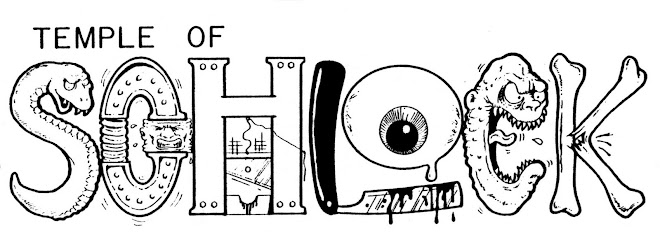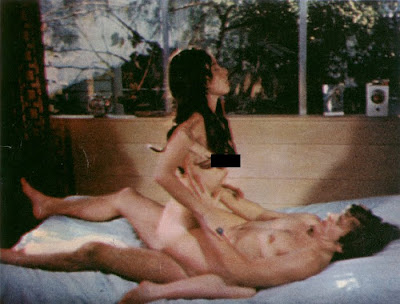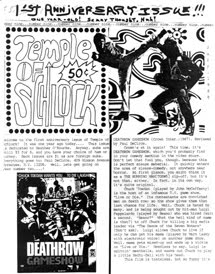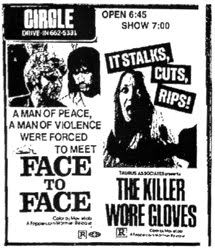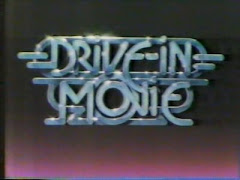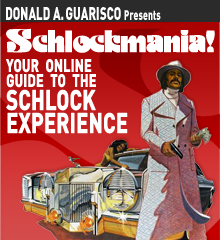If you could interview George Romero, Wes Craven, William Friedkin, and just about every other living legend of 1970s movie horror, what would you ask them? A journalist named Jason Zinoman, who first covered this subject matter for a story in Vanity Fair, found himself in that enviable position, and the result is a book called Shock Value: How a Few Eccentric Outsiders Gave Us Nightmares, Conquered Hollywood, and Invented Modern Horror.
So much has already been written about this era that Mr. Zinoman's real challenge was to come up with new and interesting material. The good news? He is more than up to the task. Where he falls down -- not just falls, but crashes and burns -- is that his book is filled with mistakes. Dates are wrong, citations are incorrect, plot points are sometimes astoundingly off ... perfection is one thing, but Shock Value contains so many howlers that when the author at one point accuses the original HALLOWEEN of being "riddled with errors, big and small," it's hard not to cringe.
Shock Value's focus is the first eleven years of "New Horror" that Mr. Zinoman claims began in 1968 with ROSEMARY'S BABY. "Old Horror" was cobwebs and castles and Vincent Price in a cape. "New Horror" relocated the menace to everyday settings with ambitious young directors at the helm; the author observes that pre-1968 movie horror was the province of actors like Price, while the directors "were largely unknown and considered easily replaceable." The original director of ROSEMARY'S BABY was "Old Horror" vet William Castle, known more for his elaborate gimmicks than for the quality of his films. However, the studio's decision to go with the younger, hipper Roman Polanski -- relegating Castle to producer -- not only changed the direction of movie horror, but also symbolized "a passing of the torch from the Old Horror to the New."
In addition to Polanski, Romero, Craven and Friedkin, Mr. Zinoman identifies John Carpenter, Dan O'Bannon, Tobe Hooper and Brian De Palma as the most important of the "New Horror" filmmakers. One of the book's tenets is that these men paid homage to their forefathers (particularly Alfred Hitchcock), while at the same time rebelling against them, most significantly by refusing to provide easy answers. Therefore, while PSYCHO concluded with a lengthy explanation of Anthony Perkins' madness, the new directors opted instead for "ambiguity and confusion," finding them to be "scarier than certainty." Insisting that Hitchcock's influence is overrated, Mr. Zinoman points instead to H.P. Lovecraft and to live theater, particularly the plays of Harold Pinter ("no playwright had a greater influence on horror") and Samuel Beckett (when making HALLOWEEN, John Carpenter was "[i]nfluenced by the terror of Beckett" and "wanted an empty space at the heart of the movie, where the answers usually are").
Mr. Zinoman has a gift for digging up interesting background on familiar material, including a fascinating chapter on how THE TEXAS CHAIN SAW MASSACRE was bankrolled ("the tale began the same way that the movie ended: with an obsessed man chasing a beautiful woman"). He also calls attention to movies that haven't necessarily gotten their due, including Peter Bogdanovich's 1968 TARGETS, whose "chillingly matter-of-fact style ... anticipated the future of the genre in some ways even more than ROSEMARY'S BABY and NIGHT OF THE LIVING DEAD."
If for no other reason, the book is indispensable for documenting FOSTER'S RELEASE, a 1971 student feature directed by John Carpenter's film school classmate Terence Winkless. The story of a babysitter terrorized by threatening phone calls (coming from inside the house!), FOSTER'S RELEASE was years ahead of BLACK CHRISTMAS, WHEN A STRANGER CALLS, and of course HALLOWEEN, about which Mr. Winkless is quoted as saying, without rancor, "John took it from me no question." Although he seems congenial and easygoing in interviews and DVD audio commentaries, Carpenter comes across here as something of a ruthless jerk who "had been sponging up ideas throughout the decade."
The author bends over backward to paint these "New Horror" filmmakers as misunderstood loners -- the "eccentric outsiders" of the title -- but by and large they seem here like pretty average guys who happen to have talent and leadership ability. The book's most memorable passages are those that probe into their personal histories, yielding some surprisingly intimate and touching results. This might be the first time that Brian De Palma (in a chapter called "He Likes To Watch") has opened up publicly about his troubled family life and its link to the voyeurism theme in his movies. Equally affecting is the portrait of Dan O'Bannon and his father Thomas, a Missouri "hillbilly" whose affection for his only child was preserved in a handwritten journal called "The Book of Daniel."
Dan O'Bannon never hit the heights of his Shock Value colleagues, and his journey seems to have been the roughest. Seething with bitterness toward his former friend and collaborator John Carpenter (who O'Bannon once described as "somewhere below Wes Craven"), and resentful of the success he never quite achieved, O'Bannon was tormented by the Crohn's disease that would claim his life in 2009 -- although, ironically, the stomach pain from that ailment apparently inspired ALIEN's infamous chest-bursting scene.
What undermines Shock Value is its staggering over-abundance of bad information. How did this happen? We are informed that Russell Streiner "played a policeman" in the original NIGHT OF THE LIVING DEAD; that "Bernard Herrmann's shrieking violins from PSYCHO" are played just before the closing credits in CARRIE; that in THE HILLS HAVE EYES, "Craven borrowed a plot device from ROSEMARY'S BABY (the trick of a phone call to the protagonist that looks reassuring but is actually a fake)." A longer list appears at the end of this review.
For some reason, Mr. Zinoman is at his shakiest when discussing LAST HOUSE ON THE LEFT. Where on earth did he come up with the idea that one character "is slashed to death by an electric boat fan"? Or that the lead killer Krug carves the word "Love" onto a victim's chest? Or that the villains "spit at" their victims?
It also seems like a stretch to argue that LAST HOUSE's "dramatic center was an excruciating rape scene" where the attackers "take turns raping one girl" and "make her friend watch." Presumably the author is referring to the early scene in the apartment, when the girls Mari and Phyllis are first taken captive. Phyllis is raped while the camera lingers on Mari's face. But excruciating? This part of the movie is relatively tame compared with the much rougher and more graphic scenes to follow, including the "piss your pants" sequence in the woods and Mari's mutilation/rape by Krug.
Mr. Zinoman further argues that LAST HOUSE takes place in "a godless world" that "includes no struggle with faith." Actually, Mari and her parents are established as Christians -- Mrs. Collingwood mentions God during the opening sequence, and Mari prays aloud moments before her death. The Collingwoods also display a Bible in their living room, at which Krug pokes fun. Characters in Wes Craven's movies are often people of faith, although it seldom serves to protect them from harm.
In the end, the many inaccuracies don't prevent Shock Value from being a worthwhile book. It should make for interesting reading for newcomers and diehard fans of the genre alike: it's a very good introduction to 1970s horror; and for skeptical fans who think they already know everything, there are some pleasant surprises.
**(Following is a list, arranged by chapter, both of outright errors and also what might be errors)**
---INTRODUCTION---
In LAST HOUSE ON THE LEFT, "Krug carved the word 'Love'" onto his victim's chest (p. 2). Two paragraphs later on the same page, the author writes that Krug carved "his initials." He carves his first name.
The author quotes the tagline for the LAST HOUSE ON THE LEFT ad campaign as "Just keep telling yourself: It's Only a Movie. It's Only a Movie."
The tagline is "To avoid fainting keep repeating, It's Only a Movie ..."
---CHAPTER ONE ("The Devil's Advocate")---
The author writes that William Castle read the galleys for the novel Rosemary's Baby and that one day later his wife read "the script" (p. 12).
She would have read the galleys, since the novel hadn't even been published yet.
---CHAPTER TWO ("The Problem with Psycho")---
"Directors of the horror movies of the late sixties and seventies wanted more ... rock music" in their movies, among other things (pp. 30-31).
None of the directors profiled here relied on rock music in their films.
The author maintains that Alfred Hitchcock "scoffed at a screening of De Palma's DRESSED TO KILL," and quotes John Landis as saying that Hitchcock "'was personally insulted because in the ads, all the critics said that the movie was Hitchcockian'" (p. 31).
Hitchcock died in April 1980 and DRESSED TO KILL was not released until July, three months later. While it's possible that Hitchcock could have seen an early preview of the movie, it doesn't seem very likely, as he was (according to his biographers) in failing health in the months before his death. However, assuming that he did see a preview, there would have been no ads or critical commentary at such an early date.
Herschell Gordon Lewis' TWO THOUSAND MANIACS! "showed the nipples of a woman cut off, milk dribbling out of the holes in her breasts" (p.34).
This scene was in Lewis' THE GORE-GORE GIRLS.
NIGHT OF THE LIVING DEAD "opened ... to admiring reviews in the summer of 1968" (p. 37). On page 47, the author again cites NOTLD as one "of the major horror movies of the summer of 1968."
First, NOTLD's world premiere was in the fall (10-1-68 in Pittsburgh). Second, was it considered a major release? And did it receive any admiring reviews at that time? Variety panned it in their 10-16-68 issue, and the New York Times followed suit when it opened there in December. The movie didn't open in Los Angeles until January 1969, but it did receive a positive review from Los Angeles Times critic Kevin Thomas. (Mr. Zinoman cites the French journal Cahiers du Cinema as having praised the movie, but that wasn't until 1970.)
---CHAPTER FOUR ("Assaulting the Audience")---
All of the comments below are about LAST HOUSE ON THE LEFT:
The movie's "dramatic center was an excruciating rape scene" (p. 74). See discussion in review above.
The killers "abduct two middle-class girls in the woods" and "spit at them," among other things (p. 75).
The girls are abducted in the city and later taken to the woods. Although Krug drools on Mari while raping her, the only person who actually gets "spit at" is one of the killers (Weasel) by a victim (Phyllis).
Wes Craven "claims the graphic murders were a response to the media's delicate treatment of the Vietnam War" (p. 79).
Craven has stated the opposite -- that the media's explicit TV coverage brought the raw horror of war and bloodshed into people's living rooms for the first time, and therefore the public was no longer able to accept conventionally tidy movie deaths.
The movie takes place in "a godless world" that "includes no struggle with faith" (p. 79).
See discussion in review above.
"Junior desperately wants his [father Krug's] attention" (p. 79).
Is this really true? While resentful of his father, Junior never seems to be craving his attention.
The author refers to Mr. and Mrs. Collingwood as "the parents of the victims" (p. 79) instead of the parents of *one of* the victims.
The Collingwoods "do not do the civilized thing and call the police" once they have identified their daughter's killers (p. 80).
They are unable to call the police because the phone is dead.
In the revenge sequence, one "character is slashed to death by an electric boat fan" (p. 80).
Is the author confusing this with the ending of the original I SPIT ON YOUR GRAVE, where one of the rapists is killed with a speedboat's propellers?
The castration scene is "[o]ne of the most humiliating scenes" in the movie (p. 80).
I guess it's a matter of opinion, but considering the many more disturbing moments in the movie, calling this scene "humiliating" seems like a stretch. It inspires more groans or laughs than anything else.
When LAST HOUSE first "started getting picked up by theaters," it "mov[ed] from city to city in short runs" (p. 81).
Actually, it had lengthy runs in several cities. It also opened in multiple cities at once, such as Chicago, Cleveland, Milwaukee and Washington, DC (in October 1972). This raises doubt about the author's assertion that "[t]here were very few prints" of the movie (p. 82).
Roger Ebert's column about watching NIGHT OF THE LIVING DEAD at a matinee filled with children was "a story for Reader's Digest in 1970" (p. 83).
The story was published in the Chicago Sun-Times in January 1969, and was reprinted in June 1969 in Reader's Digest.
"As a kid, George Romero stayed up nights in New York curled up in bed reading old copies" of Famous Monsters of Filmland (p. 84).
Romero was born in 1940 and Famous Monsters was not published until 1958.
---CHAPTER FIVE ("Shock or Awe")---
THE OMEN "returned to the theme of a woman who gives birth to the Antichrist" (pp. 103-104).
The woman (Lee Remick) gives birth to a normal child who is secretly replaced by the Antichrist, whose mother was "a jackal."
---CHAPTER SEVEN ("The Dance of Death")---
In THE TEXAS CHAIN SAW MASSACRE, "Sally Hardesty" is "the pretty blonde" (p. 127).
The other girl (Pam) is blond too.
"Before heading into the house for the first kill by Leatherface, the roaming camera sets up behind a blond girl on a swing" (p. 141).
This is the second kill. The first kill is the blond girl's boyfriend, while she waits outside on the swing. Eventually she gets up to look for him, which is when the camera follows her into the house.
"Prominent critics," including Roger Ebert, did not start taking THE TEXAS CHAIN SAW MASSACRE seriously until two years after its original release, and the author quotes Ebert's Chicago Sun-Times review (pp. 147-148).
Ebert's review appeared at the time of the movie's original release in October 1974.
---CHAPTER EIGHT ("He Likes to Watch")---
**The author quotes Brian De Palma's description of an experimental theater performance where a man threw coins at the stage and hit an actress, who responded violently. "'She went after her,'" the author writes, instead of "She went after him" (p. 160).
"As CARRIE returns to the bird's-eye view of the opening shot right before the credits, Bernard Herrmann's shrieking violins from PSYCHO can be heard" (p.168).
The shrieking violins appear elsewhere in CARRIE, but not in the final scene.
Nancy Allen in CARRIE "started working on the scene with P.J. Soles on top of a ladder" (p. 170).
Nancy Allen and P.J. Soles are on the floor in this scene; two other actresses (Amy Irving and Noelle North) are on top of the ladder.
---CHAPTER NINE ("The Thing In-Between")---
THE HILLS HAVE EYES "places a lost family in the middle of the desert, where they are abducted by a mutant gang of maniacs" (p. 176).
Only one person (an infant) is abducted.
In THE HILLS HAVE EYES, "Craven borrowed a plot device from ROSEMARY'S BABY (the trick of a phone call to the protagonist that looks reassuring but is actually a fake" (p. 177).
There is no "fake" phone call to the protagonist in ROSEMARY'S BABY.
At the end of HALLOWEEN, "when Laurie asks the doctor about who the killer was ... [h]e simply tells her, 'It's the bogeyman'" (p. 182).
He tells her, "As a matter of fact, it was."
**The author writes that the audience never sees the killer in BLACK CHRISTMAS "except for one shot of his eyes peeking out of the crack in the door to the attic" (p. 186).
The audience glimpses the killer in Margot Kidder's death scene. Also, the eye (just one) mentioned above is peeking out of the crack in a bedroom door, not the attic door. (There is no door to the attic: it is reached via a ladder and trapdoor.)
HALLOWEEN was released in 1978 "with a carefully planned rollout starting in Kansas City, far away from the media on the coasts. It moved on to Chicago ..." (p. 188).
Actually, Los Angeles and New York were among the first (if not the first) cities where the movie opened in October 1978. It did not reach Chicago until mid-November.
One of the "early reviews" of HALLOWEEN came from Roger Ebert, who "singled it out on his popular television show AT THE MOVIES" (p. 188).
At that time, the show was called SNEAK PREVIEWS and was co-hosted by Ebert and Gene Siskel. When HALLOWEEN opened in Chicago in November 1978, Siskel and Ebert reviewed (and praised) it on their show. However, the author here cites a 1980 SNEAK PREVIEWS episode on the "slasher movie" trend, not the 1978 episode where HALLOWEEN was originally reviewed. (Ebert and Siskel also gave HALLOWEEN very favorable print reviews in their respective newspapers.)
---CHAPTER TEN ("Stomaching It")---
"Carpenter went on to make his own repulsive movie in his 1981 remake of THE THING FROM ANOTHER WORLD" (p. 207).
The remake (THE THING) was released in 1982.
---CHAPTER ELEVEN ("The Fear Sickness")---
**The author mentions DARK STAR as "more influential than great" (p. 214). Can DARK STAR be considered influential?
---EPILOGUE---
Russell Streiner "played a policeman" in NIGHT OF THE LIVING DEAD (p. 232).
He played Johnny, the first victim in the opening cemetery scene!
---NOTES---
Roger Ebert's article "Just Another Horror Movie--Or Is It?" originally appeared in the Chicago Sun-Times in January 1969. However, it is incorrectly cited twice as a Reader's Digest article, and with two different dates: June 1969 (in the Notes for Chapter 4) and June 1968 (in the Notes for Chapter 5).
Roger Ebert's Chicago Sun-Times reviews of MACBETH, THE TEXAS CHAIN SAW MASSACRE and JAWS are each cited incorrectly, with January 1 given as the date that each review initially appeared. The actual publication dates are: MACBETH (4/3/72), THE TEXAS CHAIN SAW MASSACRE (10/30/74) and JAWS (6/20/75).
Review & research by Jon Putnam
